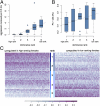Social environment is associated with gene regulatory variation in the rhesus macaque immune system
- PMID: 22493251
- PMCID: PMC3340061
- DOI: 10.1073/pnas.1202734109
Social environment is associated with gene regulatory variation in the rhesus macaque immune system
Abstract
Variation in the social environment is a fundamental component of many vertebrate societies. In humans and other primates, adverse social environments often translate into lasting physiological costs. The biological mechanisms associated with these effects are therefore of great interest, both for understanding the evolutionary impacts of social behavior and in the context of human health. However, large gaps remain in our understanding of the mechanisms that mediate these effects at the molecular level. Here we addressed these questions by leveraging the power of an experimental system that consisted of 10 social groups of female macaques, in which each individual's social status (i.e., dominance rank) could be experimentally controlled. Using this paradigm, we show that dominance rank results in a widespread, yet plastic, imprint on gene regulation, such that peripheral blood mononuclear cell gene expression data alone predict social status with 80% accuracy. We investigated the mechanistic basis of these effects using cell type-specific gene expression profiling and glucocorticoid resistance assays, which together contributed to rank effects on gene expression levels for 694 (70%) of the 987 rank-related genes. We also explored the possible contribution of DNA methylation levels to these effects, and identified global associations between dominance rank and methylation profiles that suggest epigenetic flexibility in response to status-related behavioral cues. Together, these results illuminate the importance of the molecular response to social conditions, particularly in the immune system, and demonstrate a key role for gene regulation in linking the social environment to individual physiology.
Conflict of interest statement
The authors declare no conflict of interest.
Figures





Similar articles
-
Agonism and grooming behaviour explain social status effects on physiology and gene regulation in rhesus macaques.Philos Trans R Soc Lond B Biol Sci. 2022 Feb 28;377(1845):20210132. doi: 10.1098/rstb.2021.0132. Epub 2022 Jan 10. Philos Trans R Soc Lond B Biol Sci. 2022. PMID: 35000435 Free PMC article.
-
Dominance rank-associated gene expression is widespread, sex-specific, and a precursor to high social status in wild male baboons.Proc Natl Acad Sci U S A. 2018 Dec 26;115(52):E12163-E12171. doi: 10.1073/pnas.1811967115. Epub 2018 Dec 11. Proc Natl Acad Sci U S A. 2018. PMID: 30538194 Free PMC article.
-
The Signature of Maternal Social Rank in Placenta Deoxyribonucleic Acid Methylation Profiles in Rhesus Monkeys.Child Dev. 2017 May;88(3):900-918. doi: 10.1111/cdev.12640. Epub 2016 Oct 14. Child Dev. 2017. PMID: 27739069 Free PMC article.
-
Genetic studies on the Cayo Santiago rhesus macaques: A review of 40 years of research.Am J Primatol. 2016 Jan;78(1):44-62. doi: 10.1002/ajp.22424. Epub 2015 Jun 1. Am J Primatol. 2016. PMID: 26031601 Review.
-
Co-evolution of the MHC class I and KIR gene families in rhesus macaques: ancestry and plasticity.Immunol Rev. 2015 Sep;267(1):228-45. doi: 10.1111/imr.12313. Immunol Rev. 2015. PMID: 26284481 Free PMC article. Review.
Cited by
-
A female-biased gene expression signature of dominance in cooperatively breeding meerkats.Mol Ecol. 2024 Nov;33(21):e17467. doi: 10.1111/mec.17467. Epub 2024 Jul 17. Mol Ecol. 2024. PMID: 39021304
-
Epigenetic signatures of social status in wild female spotted hyenas (Crocuta crocuta).Commun Biol. 2024 Mar 28;7(1):313. doi: 10.1038/s42003-024-05926-y. Commun Biol. 2024. PMID: 38548860 Free PMC article.
-
Genetically identical mice express alternative reproductive tactics depending on social conditions in the field.Proc Biol Sci. 2024 Mar 27;291(2019):20240099. doi: 10.1098/rspb.2024.0099. Epub 2024 Mar 20. Proc Biol Sci. 2024. PMID: 38503332
-
Immune cell composition varies by age, sex and exposure to social adversity in free-ranging Rhesus Macaques.Geroscience. 2024 Apr;46(2):2107-2122. doi: 10.1007/s11357-023-00962-8. Epub 2023 Oct 18. Geroscience. 2024. PMID: 37853187 Free PMC article.
-
The biology of aging in a social world: Insights from free-ranging rhesus macaques.Neurosci Biobehav Rev. 2023 Nov;154:105424. doi: 10.1016/j.neubiorev.2023.105424. Epub 2023 Oct 11. Neurosci Biobehav Rev. 2023. PMID: 37827475 Free PMC article. Review.
References
-
- Cohen S, et al. Chronic social stress, social status, and susceptibility to upper respiratory infections in nonhuman primates. Psychosom Med. 1997;59:213–221. - PubMed
-
- Sapolsky RM. The influence of social hierarchy on primate health. Science. 2005;308:648–652. - PubMed
-
- Altmann J, Alberts SC. Variability in reproductive success viewed from a life-history perspective in baboons. Am J Hum Biol. 2003;15:401–409. - PubMed
-
- Cowlishaw G, Dunbar RIM. Dominance rank and mating success in male primates. Anim Behav. 1991;41:1045–1056.
Publication types
MeSH terms
Associated data
- Actions
Grants and funding
LinkOut - more resources
Full Text Sources
Other Literature Sources

